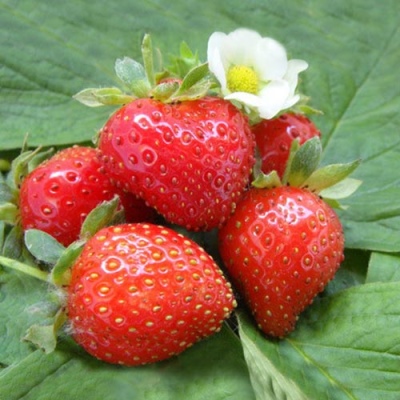
- Authors: Peter Vinson (UK)
- Taste: sweet
- The size: large
- Weight: 25 g
- Yield rate: high
- Yield: 1-2 kg per bush
- Repairability: Yes
- Advantages: fruits are well stored, unpretentious to weather and soil conditions, gives 3-4 harvests per season
- Appointment: universal
- Description of the bush: sprawling
Breeding work on obtaining varieties of strawberries with increased productivity, disease resistance and sugar taste is being carried out in different countries both within the framework of government programs and at private enterprises. One of the oldest agricultural corporations in Great Britain became the originator of the very successful Sweet Evie variety.
Breeding history of the variety
Sweet Eve was bred in 2008 by the family business Edward Vinson Ltd - a nursery with more than 150 years of history, located in Kent. The variety breeder, Peter Vinson, son of the founder of the farm, has devoted more than 25 years to researching strawberry varieties. In honor of Edward Vinson, the names of varieties released since 1990 begin with his initials: Everest, Eve's Delight, Everglade, Sweet Eve.
Sweet Eve is a cross between non-patented varieties 01BB64 (UK) and S01R5 (Spain). In 2010, Sweet Eve was approved for commercial use and received widespread acclaim. The variety was awarded the Superior Taste Award 2019 for its excellent taste.
Description of the variety
Sweet Evie is a universal British remontant variety, unpretentious in agricultural technology, high-yielding, large-fruited and moderately winter-hardy (up to –25 ° C without shelter). Grown in open ground, greenhouses and even on the balcony.
The fruits have a pronounced aroma, very sweet taste and uniformity in size and shape. The variety has an excellent presentation and transportability. Berries are eaten fresh and used for harvesting.
Ripening terms
These strawberries are classified as NSD (neutral daylight hours), yielding from late May to October. Many call such varieties remontant, but unlike classic remontant varieties, they do not require a large interval between summer and autumn fruiting. They bloom, form ovaries and bear fruit, regardless of the length of daylight hours, almost continuously.
Growing regions
First of all, the variety is adapted by the creators to the growing conditions in the south-east of England, ideal for the temperate and humid climate of the Nordic countries. Many Dutch nurseries cultivate Sweet Evie for worldwide sales. The variety quickly spread in Ukraine, in Belarus, and is beginning to gain popularity in Russia.
Yield
The Evy suite forms a large number of brushes and ovaries on medium-sized (about 30 cm) spreading bushes and gives a high yield (3-4 times per season). The peak of fruiting occurs at the end of June. Up to 2 kg of fruits are harvested from one bush.
Berries and their taste
Sweet Eve berries are large (up to 20-25 g), regular conical shape, have a glossy bright red-orange color, firm, dense skin and juicy flesh. Albion is an American strawberry, which is famous for its high yield and good taste, which is close in characteristics to Sweet Evie. Sweet Evie surpasses Albion in sugar level, berry aroma and yield stability. The texture of the flesh is less dense than that of Albion, without crunch, so the tasting experience is more pleasant.
According to Peter Vinson, consumers today have begun to eliminate excess sugar in their diets and are trying to eat strawberries in their pure form, without sweet cream and powdered sugar.The aim of the breeding work was to create a berry that does not need additional sweeteners. Sweet Evie fully fulfills this task, having a Brix of 11.1%.
Sweet Evi fruits do not darken when stored in the refrigerator (they can be kept in it for about 3 days), are perfectly transported: they do not crumple during transportation.
Growing features
The variety turned out to be unpretentious and hardy, so its agricultural technology is quite simple:
weed removal;
loosening the soil after rain or watering (avoiding the formation of a dense crust);
moderate morning watering in the heat;
mulching;
preparation for wintering.
At the beginning of the spring-summer season, the seedlings should be fed with nitrogen fertilizer, after the formation of ovaries - with potassium sulfate. Having harvested the crop, you need to make a complex top dressing. The bushes must be renewed every 3 years.




Site selection and soil preparation
The site for planting is selected even or with a slight slope, 40-50 cm are left between the bushes, about 70 cm between the rows. The variety grows well and bears fruit in partial shade. Light and medium-density soils with a pH level of 5.0-6.6 are suitable for it. Dense clay soil should be avoided, and lime should be added to too acidic. The site is dug up before planting, adding compost and superphosphate.

Pollination
This strawberry produces large white flowers and self-pollinates without requiring enforcement measures.

One of the important techniques in strawberry care is feeding. Regular fertilization guarantees a rich harvest. There are several different ways to feed strawberries, and each of them is designed for a specific period of plant development. During flowering, fruiting and after it, feeding should be different.

Diseases and pests
The variety is resistant to major diseases: it is practically not affected by spotting, rot, powdery mildew and is resistant to tick attacks. Mulching with sawdust will help with slugs.

Strawberries are often subject to many dangerous diseases that can seriously undermine their condition. Among the most common are powdery mildew, gray mold, brown spot, anthracnose, and verticillosis. Before buying a variety, you need to inquire about its disease resistance.
Reproduction
The variety reproduces mainly by stolons (mustaches). Although you can use the division of the bush. After transplanting, Sweet Evie rosettes take root well.



















































































